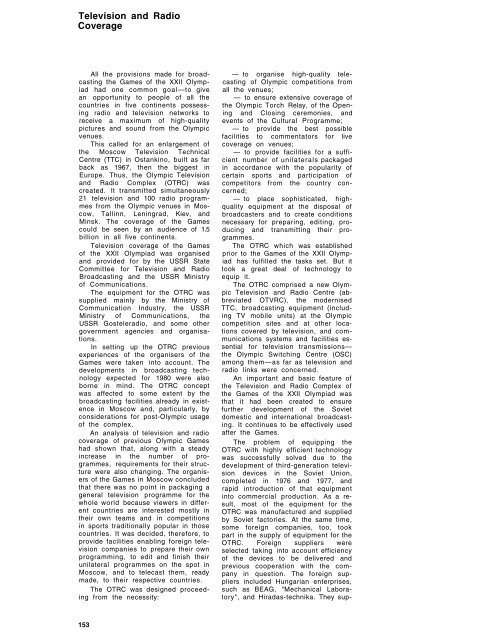or1980v2pt1
or1980v2pt1
or1980v2pt1
You also want an ePaper? Increase the reach of your titles
YUMPU automatically turns print PDFs into web optimized ePapers that Google loves.
Television and Radio<br />
Coverage<br />
All the provisions made for broadcasting<br />
the Games of the XXII Olympiad<br />
had one common goal—to give<br />
an opportunity to people of all the<br />
countries in five continents possessing<br />
radio and television networks to<br />
receive a maximum of high-quality<br />
pictures and sound from the Olympic<br />
venues.<br />
This called for an enlargement of<br />
the Moscow Television Technical<br />
Centre (TTC) in Ostankino, built as far<br />
back as 1967, then the biggest in<br />
Europe. Thus, the Olympic Television<br />
and Radio Complex (OTRC) was<br />
created. It transmitted simultaneously<br />
21 television and 100 radio programmes<br />
from the Olympic venues in Moscow,<br />
Tallinn, Leningrad, Kiev, and<br />
Minsk. The coverage of the Games<br />
could be seen by an audience of 1.5<br />
billion in all five continents.<br />
Television coverage of the Games<br />
of the XXII Olympiad was organised<br />
and provided for by the USSR State<br />
Committee for Television and Radio<br />
Broadcasting and the USSR Ministry<br />
of Communications.<br />
The equipment for the OTRC was<br />
supplied mainly by the Ministry of<br />
Communication Industry, the USSR<br />
Ministry of Communications, the<br />
USSR Gosteleradio, and some other<br />
government agencies and organisations.<br />
In setting up the OTRC previous<br />
experiences of the organisers of the<br />
Games were taken into account. The<br />
developments in broadcasting technology<br />
expected for 1980 were also<br />
borne in mind. The OTRC concept<br />
was affected to some extent by the<br />
broadcasting facilities already in existence<br />
in Moscow and, particularly, by<br />
considerations for post-Olympic usage<br />
of the complex.<br />
An analysis of television and radio<br />
coverage of previous Olympic Games<br />
had shown that, along with a steady<br />
increase in the number of programmes,<br />
requirements for their structure<br />
were also changing. The organisers<br />
of the Games in Moscow concluded<br />
that there was no point in packaging a<br />
general television programme for the<br />
whole world because viewers in different<br />
countries are interested mostly in<br />
their own teams and in competitions<br />
in sports traditionally popular in those<br />
countries. It was decided, therefore, to<br />
provide facilities enabling foreign television<br />
companies to prepare their own<br />
programming, to edit and finish their<br />
unilateral programmes on the spot in<br />
Moscow, and to telecast them, ready<br />
made, to their respective countries.<br />
The OTRC was designed proceeding<br />
from the necessity:<br />
153<br />
— to organise high-quality telecasting<br />
of Olympic competitions from<br />
all the venues;<br />
— to ensure extensive coverage of<br />
the Olympic Torch Relay, of the Opening<br />
and Closing ceremonies, and<br />
events of the Cultural Programme;<br />
— to provide the best possible<br />
facilities to commentators for live<br />
coverage on venues;<br />
— to provide facilities for a sufficient<br />
number of unilaterals packaged<br />
in accordance with the popularity of<br />
certain sports and participation of<br />
competitors from the country concerned;<br />
— to place sophisticated, highquality<br />
equipment at the disposal of<br />
broadcasters and to create conditions<br />
necessary for preparing, editing, producing<br />
and transmitting their programmes.<br />
The OTRC which was established<br />
prior to the Games of the XXII Olympiad<br />
has fulfilled the tasks set. But it<br />
took a great deal of technology to<br />
equip it.<br />
The OTRC comprised a new Olympic<br />
Television and Radio Centre (abbreviated<br />
OTVRC), the modernised<br />
TTC, broadcasting equipment (including<br />
TV mobile units) at the Olympic<br />
competition sites and at other locations<br />
covered by television, and communications<br />
systems and facilities essential<br />
for television transmissions—<br />
the Olympic Switching Centre (OSC)<br />
among them—as far as television and<br />
radio links were concerned.<br />
An important and basic feature of<br />
the Television and Radio Complex of<br />
the Games of the XXII Olympiad was<br />
that it had been created to ensure<br />
further development of the Soviet<br />
domestic and international broadcasting.<br />
It continues to be effectively used<br />
after the Games.<br />
The problem of equipping the<br />
OTRC with highly efficient technology<br />
was successfully solved due to the<br />
development of third-generation television<br />
devices in the Soviet Union,<br />
completed in 1976 and 1977, and<br />
rapid introduction of that equipment<br />
into commercial production. As a result,<br />
most of the equipment for the<br />
OTRC was manufactured and supplied<br />
by Soviet factories. At the same time,<br />
some foreign companies, too, took<br />
part in the supply of equipment for the<br />
OTRC. Foreign suppliers were<br />
selected taking into account efficiency<br />
of the devices to be delivered and<br />
previous cooperation with the company<br />
in question. The foreign suppliers<br />
included Hungarian enterprises,<br />
such as BEAG, "Mechanical Laboratory",<br />
and Hiradas-technika. They sup-


